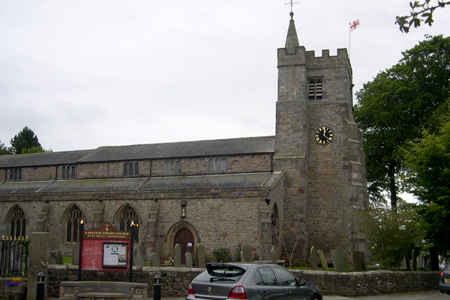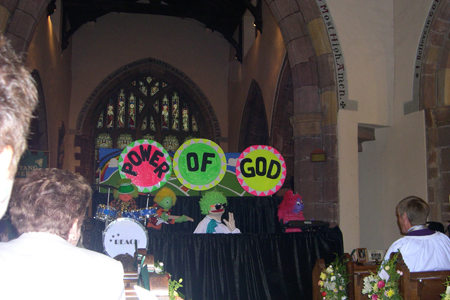| |
 |
 |
 |
| Comment on this report, or find other reports. |
 |
| Our Mystery Worshippers are volunteers who warm church pews for us around the world. If you'd like to become a Mystery Worshipper, start here. |
 |
| Find out how to reproduce this report in your church magazine or website. |
|
|
| 1806: St Helen,
Garstang Parish, Churchtown, Lancashire, England |
 |
 |
 |
Mystery Worshipper:
Chris Teeyan.
The church:
St
Helen, Garstang Parish, Churchtown, Lancashire, England.
Denomination:
Church of England, Diocese
of Blackburn.
The building:
St Helen's is a beautiful ancient church surrounded by a large
graveyard, whose circular shape suggests that the church was
built on an early pagan site of worship before being taken over
by Christianity. It was begun in Norman times, and the board
in the church shows the first vicar was installed in 1190. A
12th century carving of St Helen can be seen above the north
door. Additions have been made over the years in various architectural
styles. The end result is a typical English village church complete
with a rather squat bell tower. Although there are some plain
windows, many are in stained glass, mostly by Ward and Hughes,
famous for the re-glazing of the east window of Lincoln Cathedral.
The high altar is backed by a magnificent east window depicting
scenes from the life of Our Lord. Medieval choir stalls, the
rear ones with misericords, flank either side of the chancel,
and an impressive looking organ is located behind the northern
choir stalls. The large central nave has a wooden ceiling and
is separated from its side aisles and the sanctuary by stone
arches decorated with words from biblical scripts and the creed.
The Lady chapel, endowed by Lady Rigmayden of Wedacre in 1529,
is a fine example of Tudor church building. King Henry IV donated
the massive beams in the roof and the window behind its altar
shows St Helen, the patron saint. The south chancel aisle is
thought to have been a chantry chapel endowed by Roger de Brockholes
in 1490. A Jacobean pulpit with arabesque carvings, dated 1646,
is to the left of the chancel steps.
The church:
There is a communion service every Sunday and an evening service
on the second and fourth Sundays of the month. The vicar also
conducts services at St Michael's church, which is a few miles
away. There seems to be an active social calendar of events
for organizations such as the Mothers' Union, flower arranging
groups, youth groups and the bell ringers. A wine tasting event
sampling wines from twin dioceses in Germany and South Africa,
a local band entertainment, and a folk concert were planned
for the following week.
The neighbourhood:
Churchtown is a picturesque sleepy village nestling in the rich,
arable Fylde countryside of Lancashire. It is just off the main
road that leads from the market town of Garstang, three miles
away, to the bustling seaside resort of Blackpool, some twelve
miles away. Many people must drive past not realising what a
gem they are missing. The church, known locally as the Cathedral
of the Fylde, lies at the bottom of a narrow cul-de-sac aptly
named Church Street lined with old pretty cottages and a village
pub, all adorned with hanging baskets and tubs crammed with
colourful flowers.
The cast: The Revd Andrew Wilkinson, vicar, was the celebrant. He was assisted by his curate, the Revd Constance Whalley, who read the gospel and led the prayers of intercession.
The date & time:
Sunday, 23 August 2009, 11.00am.
What was the name of the service?
Festival Eucharist with puppet show.
How full was the building?
I think there would be at least 100 people in the congregation, which was a complete mix of ages from babies to nonagenarians.
Did anyone welcome you personally?
We arrived early but we were greeted and made welcome by various
sidesmen and parishioners. It turned out that the church was
celebrating its annual patronal festival, so on entering through
the south porch we were met with a church full of floral displays
and exhibitions dedicated to the Year of the Child 2009. We
found we were going to be treated to a puppet show (!) and indeed
a huge black stage had been mounted on the chancel steps, blocking
out most of the chancel and sanctuary.
Was your pew comfortable?
The traditional wooden pew was as comfortable as one might expect,
but the rather new looking hassocks were deeply cushioned and
very comfortable. This was obviously a church where it was traditional
to kneel when praying.
How would you describe the pre-service
atmosphere?
It was fairly quiet with a few whispered conversations. The organ was being played quietly and four people were ringing the bells.
What were the exact opening words of the
service?
"We welcome you in the name of the Father, the Son and
the Holy Ghost."
What books did the congregation use during the
service?
Hymns Ancient and Modern and Common Worship Holy
Communion 1 in traditional language.
What musical instruments were played?
Mr Paul Harrison played a traditional early 19th century pipe
organ with expertise.

Did anything distract you?
When the vicar said, "The peace of the Lord be always with
you," I put down my hymnbook, preparing to exchange peace
with others. But it didn't happen! The service just carried
on. Is this something else we have to forgo because of the threat
of swine flu? I wondered to myself. In the Church of England
we no longer receive from the chalice because of this threat.
Was the worship stiff-upper-lip, happy clappy, or
what?
It was fairly high church, undoubtedly different from their
usual form of worship because of the puppet show. Access to
the chancel and sanctuary was completely blocked because of
the stage, so there was no procession to start the service.
The vicar and curate both wore cream albs over which the vicar
wore a cream chasuble and the curate wore a cream stole. They
stood in front of the pulpit at the start of the service, whilst
the robed choir occupied the front three rows of pews. After
the puppet show, the stage was removed during the singing of
a hymn, and the service continued in a dignified manner. When
it was finished, the choir and clergy, led by the crucifer,
processed into the nave.
Exactly how long was the sermon?
25 minutes.
On a scale of 1-10, how good was the preacher?
8 – The sermon was replaced by a presentation by Reach
Puppets from Rawtenstall, a Christian youth organization
whose aim is to spread the good news of the gospel. It was introduced
by a lady who unfortunately spoke so quickly that at times it
was difficult to make out what she was saying. However, I did
manage to glean that the American television programme Sesame
Street influenced their puppet show.
In a nutshell, what was the sermon
about?
The Bible tells us how to live the best life possible. In the
New Testament, Jesus came to show us the way. He told us many
stories to help us understand how to behave and how to treat
one another. The puppets performed three sketches to show us
how to believe and adore, how much God and Jesus love us, and
how the Spirit within us is the power of God. In the first sketch,
the Lord visited Lisa in the disguise of a poor man begging
for water, food and clothes, but she rejected him because she
hadn't recognised him. The second sketch was about the parable
of the lost sheep, and the third was about how the power of
God works within us. They conveyed a profound message which
was sincerely and imaginatively delivered. It was a tribute
to Reach Puppets.
Which part of the service was like being in
heaven?
The removal of the puppet stage revealed a delightful view of
the light and airy sanctuary with its magnificent backdrop of
such an impressive huge stained glass window. The high altar
consisted of a dressed communion table with an engraved cross,
and it was adorned with flowers and candles.
And which part was like being in... er... the other place?
The third puppet sketch used unnecessary, extremely loud amplified
music. Indeed, I observed an elderly gentleman removing his
hearing aid – he probably felt his eardrum was being blown out!
One-tenth of the number of decibels would still have conveyed
the same message.
What happened when you hung around after the service looking lost?
Several people engaged us in lengthy conversation and appeared to be very sociable. Unfortunately we didn't have a chance to speak to the vicar who, after speaking to most of the congregation, was looking after the puppeteers.
How would you describe the after-service
coffee?
We actually had our coffee before the service, in the church hall. This was because we discovered the church by chance and found we had an hour to wait for the service. There was a fixed price menu of drinks and snacks and I assume this was provided because of the festival and exhibition.
How would you feel about making this church your regular (where 10 = ecstatic, 0 = terminal)?
8 – It is such a delightful church and the people are very
convivial. However, I would like to participate in a normal
Sunday service to gain a better insight into its style of worship.
Did the service make you feel glad to be a
Christian?
It definitely made me fee glad to be a Christian. I enjoyed the traditional form of worship and appreciated the skill of the puppeteers in conveying their messages to the children.
What one thing will you remember about all this in seven days' time?
Such a jewel of a church hidden in the Fylde countryside. |
|
|
 |
 |
 |
| We rely on voluntary donations to stay online. If you're a regular visitor to Ship of Fools, please consider supporting us. |
 |
 |
 |
| The Mystery Pilgrim |
 |
| One of our most seasoned reporters makes the Camino pilgrimage to Santiago de Compostela in Spain. Read here. |
 |
 |
 |
| London churches |
 |
| Read reports from 70 London churches, visited by a small army of Mystery Worshippers on one single Sunday. Read here. |
| |
|
|
|
|


